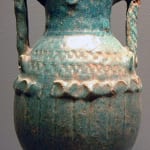Parthian, Turquoise-Glazed Terracotta Amphora, 2nd Century CE
Terracotta
10.375
X.0308
Sizeable, whitish terracotta vase with iridescent green-glaze over whole and incised and moulded decoration; body of ovoid form with tall concave-sided neck with prominent moulded rim and angular “rope” handle...
Sizeable, whitish terracotta vase with iridescent green-glaze over whole and incised and moulded decoration; body of ovoid form with tall concave-sided neck with prominent moulded rim and angular “rope” handle flanking either side. In superb condition, intact with minor hairline crack to lower body. This superb vessel heralds from Central Asia during 2nd century toward the tail end of Parthian rule (247 BCE – ACE 224). During both the Parthian and preceding Seleucid periods, there was considerable regional variation in the types of ceramic vessels produced in Mesopotamia.
When, in 7th century, the Islamic Arab armies overran the major part of the Near East, they discovered several well-established pottery centres, which had seen little change in technical skill and artistic tradition over millennia. Glazed pottery was invented and introduced in Egypt during the fourth millennium BCE and soon spread to neighbouring countries, including Parthian Iran. The manufacture of these alkaline glazed vessels continued throughout the Sassanian period right up to early Islamic times.
Given the continuity of shapes, pastes, colours and decoration over the centuries it is difficult to distinguish between pre-Islamic and early Islamic vessels. In this case however, the rope handles and buttons to the neck are useful in establishing a late Parthian date of manufacture. The same decoration can be seen on a comparable piece on display at the Tareq Rajab Museum in Kuwait.
A distinctive feature of Mesopotamian manufacture was the use of blue, green or yellow alkaline glazes. This is a particularly attractive example as the original glaze has survived with minimal weathering and retained an excellent iridescence.
The glazes on Parthian pottery form part of a long tradition of alkaline glazing in Mesopotamia. Glazes were made by mixing the ash produced by burning desert plants with crushed quartz pebbles or quartz sand. The blue and green colours are due to the presence of minor amounts of iron oxide, with or without copper.
Cf. J. Simpson, 'Partho-Sasanian ceramic industries in Mesopotamia' in Pottery in the making: world-3 (London, The British Museum Press, 1997), pp. 74-79; Geza Fehervari, ‘Ceramics of the Islamic World’ (London, I.B.Tauris, 2000) pp.23-25.
When, in 7th century, the Islamic Arab armies overran the major part of the Near East, they discovered several well-established pottery centres, which had seen little change in technical skill and artistic tradition over millennia. Glazed pottery was invented and introduced in Egypt during the fourth millennium BCE and soon spread to neighbouring countries, including Parthian Iran. The manufacture of these alkaline glazed vessels continued throughout the Sassanian period right up to early Islamic times.
Given the continuity of shapes, pastes, colours and decoration over the centuries it is difficult to distinguish between pre-Islamic and early Islamic vessels. In this case however, the rope handles and buttons to the neck are useful in establishing a late Parthian date of manufacture. The same decoration can be seen on a comparable piece on display at the Tareq Rajab Museum in Kuwait.
A distinctive feature of Mesopotamian manufacture was the use of blue, green or yellow alkaline glazes. This is a particularly attractive example as the original glaze has survived with minimal weathering and retained an excellent iridescence.
The glazes on Parthian pottery form part of a long tradition of alkaline glazing in Mesopotamia. Glazes were made by mixing the ash produced by burning desert plants with crushed quartz pebbles or quartz sand. The blue and green colours are due to the presence of minor amounts of iron oxide, with or without copper.
Cf. J. Simpson, 'Partho-Sasanian ceramic industries in Mesopotamia' in Pottery in the making: world-3 (London, The British Museum Press, 1997), pp. 74-79; Geza Fehervari, ‘Ceramics of the Islamic World’ (London, I.B.Tauris, 2000) pp.23-25.



